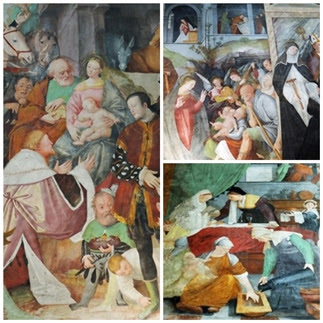Vercelli
11 April 2015
It's Saturday morning in mid-April, sunny and warm. We visited Vercelli for its layback atmosphere and an exhibition at Museum Borgogna. Close to the railway station is the first highlight of the town, Basilica of Sant’Andrea. It has awesome exterior and interior. Art inside is a treasure, both the frescoes and sculptures.
The elegant facade is built with different stones and combined with the red brickwork and white cotto of the upper part of the two side bell towers.The architecture style is Lombard-Emilian Romanesque: wide gable of the central section, two blind arcades and a big rose window in the middle.
The entrance is through three Romanesque portals. The lunette of the central portal has a relief depicting the martyrdom of St. Andrew. The left portal shows Cardinal Bicchieri offering the Church to St. Andrew. The sculptures are likely from one or more of the pupils from Benedetto Antelami who had worked in Parma Baptistery.
In the second chapel is the tomb Gallo, 14th century. The beautiful and complex architecture is a joint use of painting and sculpture.
Looking around are still beautiful sculptures. Big walls of excellent wooden paintings decorate the church admirably. You will appreciate the level of details and the fine craftsmanship.

Not far away stands the Cathedral, dedicated to Saint Eusebius of Vercelli, the first bishop. It was built in 14th century but the first church can be dated back to 4th century. Subsequent destruction and decay evolve to the present church. The only surviving part is the 12th century square campanile. Statues of the apostles and the redeemer were added to the top in 19th century.

The cathedral is shaped as Latin cross, a nave with two aisles separated by piers with paired columns. Placed above the altar is a monumental silver leaf Crucifix. It is from the end of 10th century, 3.27m high and 2.36m wide.

The subject of the fine cross is Triumphant Christ, depicted in a vertical position. At the bottom and the two ends are also small figures.

We then wandered around. A powerful red brick castle stood in front of bright yellow flowers. Churches and old buildings are dotting the city. In the morning till mid-day it was very layback. There was hardly anybody in the streets. We had a quick lunch at the main square. The warm sandwiches were good. It was delighted to sit there and see the beautiful square.
 We visited Museum Borgogna after lunch. It was quite old inside. We rang a table bell to notice staff around and purchased our tickets. Over 400 works belonging to Antonio Borgogna were displayed. Among all are about 100 detached frescoes and altarpieces by Defedente Ferrari, Giovenone, Gaudenzio Ferrari and Lanino. Unfortunately, no photo was allowed. Here are some from the museum's leaflet. Quite nice. In my opinion, those in the exhibition are still nicer.
We visited Museum Borgogna after lunch. It was quite old inside. We rang a table bell to notice staff around and purchased our tickets. Over 400 works belonging to Antonio Borgogna were displayed. Among all are about 100 detached frescoes and altarpieces by Defedente Ferrari, Giovenone, Gaudenzio Ferrari and Lanino. Unfortunately, no photo was allowed. Here are some from the museum's leaflet. Quite nice. In my opinion, those in the exhibition are still nicer.Another major tourist attraction is the Synagogue, 19th century. It is a Moorish Revival synagogue with white and red masonry.
One of the highlights of the day is certainly the marvelous paintings in the St. Christopher's Church. Every corner inside is filled with amazing fresco. Those of two big panels are especially impressive. One is illuminated but the other in the dark. Nevertheless, beautiful by the human eyes.























Comments